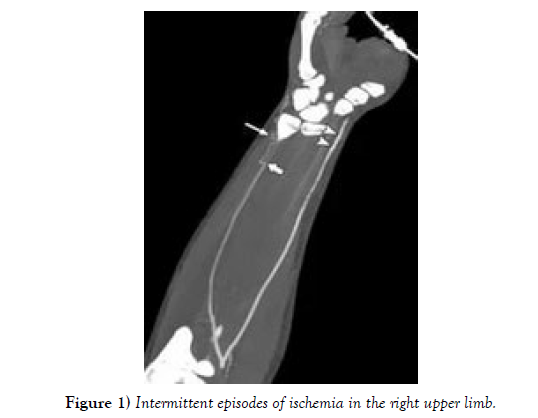Unusual Vascular Variation in the Upper Limb: A Case Report Highlighting the Importance of Clinical Anatomy
Received: 03-May-2023, Manuscript No. ijav-23-6426; Editor assigned: 04-May-2023, Pre QC No. ijav-23-6426 (PQ); Accepted Date: May 22, 2023; Reviewed: 18-May-2023 QC No. ijav-23-6426; Revised: 22-May-2023, Manuscript No. ijav-23-6426 (R); Published: 29-May-2023, DOI: 10.37532/1308-4038.16(5).263
Citation: Hvizdosova N. Unusual Vascular Variation in the Upper Limb: A Case Report Highlighting the Importance of Clinical Anatomy. Int J Anat Var. 2023;16(5):302-303.
This open-access article is distributed under the terms of the Creative Commons Attribution Non-Commercial License (CC BY-NC) (http://creativecommons.org/licenses/by-nc/4.0/), which permits reuse, distribution and reproduction of the article, provided that the original work is properly cited and the reuse is restricted to noncommercial purposes. For commercial reuse, contact reprints@pulsus.com
Abstract
Clinical anatomy plays a pivotal role in medical practice, aiding in the accurate diagnosis and effective treatment of patients. This case report presents an unusual vascular variation observed in the upper limb of a 40-year-old female patient, emphasizing the significance of clinical anatomy in understanding anatomical variations and their clinical implications. The patient presented with symptoms of intermittent upper limb ischemia, and imaging investigations revealed a rare arterial anomaly characterized by an aberrant course of the brachial artery. Through a detailed anatomical analysis, this case report sheds light on the clinical relevance of anatomical variations and highlights the importance of a thorough knowledge of clinical anatomy in providing optimal patient care.Keywords
Clinical anatomy, Anatomical variations, Upper limb, Vascular anomaly, Brachial artery, Ischemia
INTRODUCTION
Clinical anatomy plays a critical role in medical practice, providing a foundation for accurate clinical examination, precise diagnoses, and effective treatment interventions. An understanding of anatomical variations is particularly important, as they can significantly influence disease presentations, surgical procedures, and clinical outcomes. This case report aims to highlight the significance of clinical anatomy by presenting a unique vascular variation encountered in the upper limb of a patient [1].
CASE REPORT
A 40-year-old female patient presented with intermittent episodes of ischemia in the right upper limb, characterized by pain, numbness, and color changes. Physical examination revealed weak radial pulse and decreased temperature in the affected limb. Imaging investigations, including Doppler ultrasound and angiography, were performed to evaluate the vascular anatomy (Figure 1) [2].
Figure 1) Intermittent episodes of ischemia in the right upper limb.
RESULTS
The imaging studies revealed an unusual anatomical variation in the brachial artery. Instead of the typical course, where the brachial artery bifurcates into the radial and ulnar arteries at the cubital fossa, the patient exhibited an aberrant course of the brachial artery [3]. The artery took a tortuous path, encircling the humerus before giving rise to the radial and ulnar arteries. This aberrant course led to compression and subsequent ischemia during certain arm positions, explaining the patient’s symptoms [4-5].
DISCUSSION
The observed vascular anomaly highlights the importance of clinical anatomy in understanding anatomical variations and their clinical implications. Knowledge of the normal course of the brachial artery and its anatomical relationships is crucial for accurate diagnosis and appropriate management. In this case, the aberrant course of the brachial artery resulted in compression and compromised blood flow, leading to upper limb ischemic symptoms [6-7].
Clinical Significance: Anatomical variations in the vasculature can have significant implications for patient care. They can affect the success of surgical procedures, alter the distribution of blood supply, and predispose individuals to certain pathologies. In this case, the unusual vascular variation necessitated a tailored treatment plan, taking into account the aberrant anatomy to relieve the compression and restore adequate blood flow.
Importance of Clinical Anatomy: This case report underscores the vital role of clinical anatomy in healthcare practice. A thorough understanding of normal anatomy, as well as awareness of potential variations, is essential for accurate diagnoses, appropriate treatment strategies, and effective communication between healthcare professionals. Clinical anatomy serves as a bridge between basic anatomical knowledge and its practical application in patient care.
CONCLUSION
This case report highlights an unusual vascular variation in the upper limb, emphasizing the significance of clinical anatomy in understanding anatomical variations and their clinical implications. The case underscores the importance of a comprehensive knowledge of clinical anatomy in providing optimal patient care, as it allows for accurate diagnoses, appropriate treatment planning, and improved patient outcomes. By recognizing and appreciating anatomical variations, healthcare professionals can enhance their ability to deliver personalized and effective care to their patients.
CONFLICTS OF INTEREST:
None.
REFERENCES
- Brian M, Jared PB, Laura E. Thoracic surgery milestones 2.0: Rationale and revision. J Thorac Cardiovasc Surg. 2020 Nov; 160(5):1399-1404.
- Amy LH, Shari LM. Obtaining Meaningful Assessment in Thoracic Surgery Education . Thorac Surg Clin. 2019 Aug;29(3):239-247.
- Kuo-Shyang J, Shu-Sheng L, Chiung-FC. The Role of Endoglin in Hepatocellular Carcinoma. Int J Mol Sci. 2021; 22(6):3208.
- John C, Christian J. Commentary: Thoracic surgery residency: Not a spectator sport. J Thorac Cardiovasc Surg. 2020 Jun; 159(6):2345-2346.
- Anri S, Masayoshi O, Shigeru H. Glomerular Neovascularization in Nondiabetic Renal Allograft Is Associated with Calcineurin Inhibitor Toxicity. Nephron. 2020; 144 Suppl 1:37-42.
- Mamikonyan VR, Pivin EA, Krakhmaleva DA. Mechanisms of corneal neovascularization and modern options for its suppression. Vestn Oftalmo. 2016; 132(4):81-87.
- Farid MS, Kristin W, Gilles B. The History and Evolution of Surgical Instruments in Thoracic Surgery. Thorac Surg Clin. 2021 Nov; 31 (4): 449- 461.
Indexed at, Google Scholar, Crossref
Indexed at, Google Scholar, Crossref
Indexed at, Google Scholar, Crossref
Indexed at, Google Scholar, Crossref
Indexed at, Google Scholar, Crossref
Indexed at, Google Scholar, Crossref







